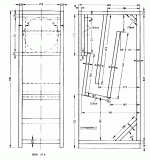
Purple Heart Veneer with a shellac finish. Turned out ok, finishing is not my forte.
nicely done - looks like they were made for each other
Thank you very much Dave!
Now, please let me know, does anybody have listening experience with this system - FE208EZ + BK-20/201? I mean I saw that some folks are saying that Fostex designs are not the most appropriate. However I find this project simple enough and this would fit my philosophy of life - things are simpler than we think.
Thank you very much again for your fast answer!
Marius
Now, please let me know, does anybody have listening experience with this system - FE208EZ + BK-20/201? I mean I saw that some folks are saying that Fostex designs are not the most appropriate. However I find this project simple enough and this would fit my philosophy of life - things are simpler than we think.
Thank you very much again for your fast answer!
Marius
Marius - count me among the folks who've commented on variable results with "Fostex factory" designs - I've heard / built several over the years and some of the larger Nagaoka manifold / BLH for FE206, etc are quite fine indeed, if not simple and lightweight. I recall helping a buddy with a pair for FE206ESRs which required something like 6 sheets of 5x5 plywood, and lots of patience on his part with the assembly
Marius - count me among the folks who've commented on variable results with "Fostex factory" designs - I've heard / built several over the years and some of the larger Nagaoka manifold / BLH for FE206, etc are quite fine indeed, if not simple and lightweight. I recall helping a buddy with a pair for FE206ESRs which required something like 6 sheets of 5x5 plywood, and lots of patience on his part with the assembly
I've built some Nagaoka Tetsuo designs and built two of the BK-16 kits for those that couldn't themselves. I loved the BK-16 design, despite being an ancient, washed up, non-computer designed horn.
I love to build & listen to different designs, but don't know anything about computer designing horns. Question for the pros, how does the software account for the varying output impedances & dampening factors of various amplifiers? Does this not change the design as the driver reacts differently and thus driver specifications change? Does this not shoot some holes in the precision of computer modeling?
The sims assume that the amp can provide the current needed at the fixed voltage setting. So a constant voltage is assumed which is pretty good for most modern solid state class AB, class A, or class D amps. However, for wildly varying impedances that are too high, a tube amplifier designed for high impedance output may be better. In my experience though, te akabak sims of a BLH are very good.
It is not beyond the wit of man to account for amplifier output impedance & its effects on the behaviour of a drive unit in the design of an enclosure, be it a horn or anything else. The ideal is to design for a specific amplifier, room acoustic & position et al. If not, then you ensure there is sufficient flexibility in the innate alignment selected to work with a range of amplifiers, room types and positions. Job jibbed. You can't please everyone, but you can provide a very effective compromise.
As for 'non-computer designed', probably the best performing bass horn designs in a technical sense were done by RCA, WE etc. back in the 1920s - 1940s when there wasn't a whole lot of digital technology available. Software allows easier / quicker design and can reduce (though certainly not eradicate) a lot of the physical prototyping & testing requirements. That is where the real advantage lies: speed & cost. You can hit broad alignments quickly; refinements can then be made via fine-tuning in the prototype stage & to an extent via additional simulation work.
Software allows easier / quicker design and can reduce (though certainly not eradicate) a lot of the physical prototyping & testing requirements. That is where the real advantage lies: speed & cost. You can hit broad alignments quickly; refinements can then be made via fine-tuning in the prototype stage & to an extent via additional simulation work.
Re 'musicality' since that varies from person to person, YMMV as ever.
As for 'non-computer designed', probably the best performing bass horn designs in a technical sense were done by RCA, WE etc. back in the 1920s - 1940s when there wasn't a whole lot of digital technology available.
Re 'musicality' since that varies from person to person, YMMV as ever.
- Status
- This old topic is closed. If you want to reopen this topic, contact a moderator using the "Report Post" button.
- Home
- Loudspeakers
- Full Range
- Madisound BK-20


